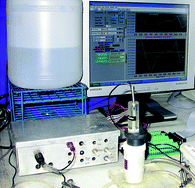A novel approach for estimation of catalase activity in biological samples was developed using real-time signal averaging with LabVIEW based virtual instrumentation. The assay was performed by on-line monitoring of the increase in dissolved oxygen concentration due to the catalytic reaction of the enzyme with its substrate H2O2 using a Clark type dissolved oxygen electrode. The electrode was interfaced with a computer using an op-amp based electronic circuit and LabVIEW based software for signal acquisition, data visualization and signal conditioning. Catalase activity in biological samples could be measured without pre-dilution and the method was not affected by interferences such as turbidity, viscosity and sample color. It was possible to increase the assay sensitivity from 0.5 U for the existing spectrophotometric method to 2.93 μU, with a sample size as little as 100 μl and response time as low as 9 s. Therefore, the proposed method shall find use in clinical assays, detection of pathogens and evaluation of catalase activity in cell cultures, neurological samples, milk and other food products.

You have access to this article
 Please wait while we load your content...
Something went wrong. Try again?
Please wait while we load your content...
Something went wrong. Try again?


 Please wait while we load your content...
Please wait while we load your content...